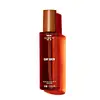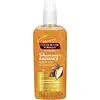What's inside
What's inside
 Key Ingredients
Key Ingredients

 Benefits
Benefits

 Concerns
Concerns

 Ingredients Side-by-side
Ingredients Side-by-side

Butyl Methoxydibenzoylmethane 3%
UV AbsorberHomosalate 10%
Skin ConditioningEthylhexyl Salicylate 5%
UV AbsorberOctocrylene 10%
UV AbsorberAlcohol
AntimicrobialC12-15 Alkyl Benzoate
AntimicrobialOctyldodecanol
EmollientDibutyl Adipate
EmollientCaprylic/Capric Triglyceride
MaskingDiethylhexyl Carbonate
EmollientDiisopropyl Sebacate
EmollientPolyester-8
Skin ConditioningLauryl Lactate
EmollientPolyamide-3
Persea Gratissima Oil
Skin ConditioningChondrus Crispus Extract
Skin ConditioningAlaria Esculenta Extract
Skin ProtectingTocopheryl Acetate
AntioxidantVitis Vinifera Seed Oil
EmollientButyrospermum Parkii Butter
Skin ConditioningArgania Spinosa Kernel Oil
EmollientCucumis Sativus Fruit Extract
EmollientHelianthus Annuus Seed Extract
Skin ConditioningHordeum Vulgare Extract
EmollientSalicornia Herbacea Extract
Skin ConditioningSqualane
EmollientGlycerin
HumectantRaphanus Sativus Seed Extract
Skin ConditioningGlycine Soja Oil
EmollientLimnanthes Alba Seed Oil
Skin ConditioningAmyris Balsamifera Bark Oil
MaskingCitrus Aurantium Amara Flower Oil
MaskingCitrus Aurantium Bergamia Fruit Oil
MaskingCoffea Arabica Seed Oil
MaskingCupressus Sempervirens Leaf/Nut/Stem Oil
EmollientHelianthus Annuus Seed Oil
EmollientMyroxylon Pereirae Oil
MaskingRosa Damascena Flower Oil
MaskingSantalum Album Oil
MaskingVanilla Planifolia Fruit Extract
Skin ConditioningDiethylhexyl Syringylidenemalonate
Skin ProtectingPentaerythrityl Tetra-Di-T-Butyl Hydroxyhydrocinnamate
AntioxidantCitric Acid
BufferingButyl Methoxydibenzoylmethane 3%, Homosalate 10%, Ethylhexyl Salicylate 5%, Octocrylene 10%, Alcohol, C12-15 Alkyl Benzoate, Octyldodecanol, Dibutyl Adipate, Caprylic/Capric Triglyceride, Diethylhexyl Carbonate, Diisopropyl Sebacate, Polyester-8, Lauryl Lactate, Polyamide-3, Persea Gratissima Oil, Chondrus Crispus Extract, Alaria Esculenta Extract, Tocopheryl Acetate, Vitis Vinifera Seed Oil, Butyrospermum Parkii Butter, Argania Spinosa Kernel Oil, Cucumis Sativus Fruit Extract, Helianthus Annuus Seed Extract, Hordeum Vulgare Extract, Salicornia Herbacea Extract, Squalane, Glycerin, Raphanus Sativus Seed Extract, Glycine Soja Oil, Limnanthes Alba Seed Oil, Amyris Balsamifera Bark Oil, Citrus Aurantium Amara Flower Oil, Citrus Aurantium Bergamia Fruit Oil, Coffea Arabica Seed Oil, Cupressus Sempervirens Leaf/Nut/Stem Oil, Helianthus Annuus Seed Oil, Myroxylon Pereirae Oil, Rosa Damascena Flower Oil, Santalum Album Oil, Vanilla Planifolia Fruit Extract, Diethylhexyl Syringylidenemalonate, Pentaerythrityl Tetra-Di-T-Butyl Hydroxyhydrocinnamate, Citric Acid
Paraffinum Liquidum
EmollientIsopropyl Palmitate
EmollientQuaternium-90 Sepiolite
Emulsion StabilisingSesamum Indicum Seed Oil
EmollientTheobroma Cacao Extract
Skin ConditioningQuaternium-90 Montmorillonite
EmulsifyingTheobroma Cacao Seed Butter
EmollientTocopherol
AntioxidantSqualane
EmollientHelianthus Annuus Seed Oil
EmollientCalcium Titanium Borosilicate
AbrasiveTitanium Dioxide
Cosmetic ColorantIron Oxides
Tin Oxide
AbrasiveSynthetic Fluorphlogopite
BHT
AntioxidantParfum
MaskingGeraniol
PerfumingCoumarin
PerfumingCitronellol
PerfumingLinalool
PerfumingParaffinum Liquidum, Isopropyl Palmitate, Quaternium-90 Sepiolite, Sesamum Indicum Seed Oil, Theobroma Cacao Extract, Quaternium-90 Montmorillonite, Theobroma Cacao Seed Butter, Tocopherol, Squalane, Helianthus Annuus Seed Oil, Calcium Titanium Borosilicate, Titanium Dioxide, Iron Oxides, Tin Oxide, Synthetic Fluorphlogopite, BHT, Parfum, Geraniol, Coumarin, Citronellol, Linalool
Ingredients Explained
These ingredients are found in both products.
Ingredients higher up in an ingredient list are typically present in a larger amount.
Helianthus Annuus Seed Oil is the oil derived from the seeds of a Sunflower. Sunflower seed oil is non-fragrant. It is an emollient, meaning it helps to soften the skin.
Sunflower seed oil contains many fatty acids. The fatty acids found in sunflower seeds include (from highest amount to least): linoleic acid, myristic acid, palmitic acid, stearic acid, arachidic acid, oleic acid, and linolenic acid.
These fatty acids help the skin create ceramides. Ceramides play a role in repairing the skin barrier.
Helianthus Annuus Seed Oil helps moisturize the skin. This in turn helps the skin look more rejuvenated and smoother.
Sunflowers are rich in vitamin E.
Historians believe Indigenous cultures of North America domesticated sunflowers before corn. Thus they relied on sunflower oil for a variety of uses. One such use is moisturizing skin and hair.
Sunflower seed oil may not be fungal acne safe. We recommend speaking with a professional if you have any concerns.
Learn more about Helianthus Annuus Seed OilSqualane is an emollient that helps the skin hold onto moisture. It's an oily liquid that occurs naturally in certain types of fish and plant oils.
Because squalane boosts hydration in the skin, it also comes with plenty of benefits: it is an antioxidant and can help fight free radicals and skin damage. Squalane is also found to have a detoxifying effect when applied.
Squalane comes from squalene, which occurs naturally within the sebum of our skin. It is one of the oils our skin produces to keep itself hydrated. Squalane is the hydrogenated version of squalene and has a longer shelf life.
Research shows that squalane is non-irritating (even at 100% concentration).
In general, it's a fantastic ingredient. It does a great job at hydrating the skin, and it's suitable for those with sensitive skin.
The source of squalane may impact malassezia / fungal acne. This is because olive oil derived squalane can contain impurities such as fatty acids and plant waxes. Sugarcane derived squalane is recommended for anyone with malassezia concerns.
Is squalane vegan?
This depends on the source. Squalane can be derived from both plants and animals. Most squalane used in skincare comes from plants.
Please note: the source of squalane is only known if disclosed by the brand. We recommend reaching out to the brand if you have any questions about their squalane.
Read more about squalene with an "e".
Is squalane an oil?
Squalane is often called an oil, but it’s technically not; it’s a hydrocarbon, meaning it’s only made of carbon and hydrogen, unlike true oils which are triglycerides made of fatty acids and glycerol.
The term “oil-free” isn’t regulated, so companies can define it however they want. Some exclude all oils, while others just avoid mineral oil or comedogenic oils.
While some people avoid oils thinking they cause breakouts, the right kind of oil (or oil-like ingredient like squalane) can actually help balance and hydrate your skin. It’s worth testing out simple oils or squalane to see what works best for your skin.
Learn more about Squalane